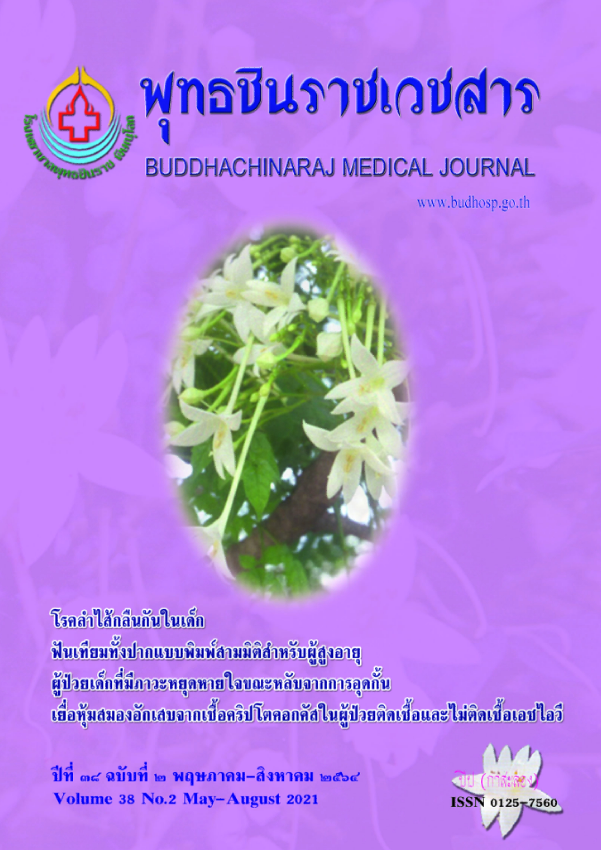บรรยากาศองค์กร ความเครียดจากงาน และการหมดไฟจากงาน ของบุคลากรในโรงพยาบาลเอกชน
บรรยากาศองค์กร ความเครียดจากงาน และการหมดไฟจากงานของบุคลากร
คำสำคัญ:
บรรยากาศองค์กร, ความเครียดจากงาน, การหมดไฟ, บุคลากร, โรงพยาบาลเอกชนบทคัดย่อ
ปัจจุบันการทำงานของบุคลากรทางการแพทย์ภาคเอกชนอยู่ในสภาวะเครียดจากบรรยากาศองค์กรและ
ตัวงานที่มุ่งเน้นความเชี่ยวชาญด้านการแพทย์ ความพึงพอใจของผู้รับบริการ ตลอดจนการจัดทำระบบมาตรฐาน
บริการทางการแพทย์ ซึ่งนำไปสู่การหมดไฟ การสำรวจนี้จึงมีวัตถุประสงค์เพื่อประเมินขนาดปัญหาของบรรยากาศ
องค์กร ความเครียดจากงาน และการหมดไฟของบุคลากรในโรงพยาบาลเอกชน โดยศึกษาในโรงพยาบาลเอกชน
แห่งหนึ่งในปี พ.ศ. 2562 ด้วยการสำมะโนในบุคลากรทั้งหมด 550 คน ซึ่งแบ่งเป็น 3 กลุ่ม คือ 1) กลุ่มแพทย์/เภสัชกร/
นักเทคนิคการแพทย์ 2) กลุ่มพยาบาล และ 3) กลุ่มสนับสนุน ด้วยแบบวัดบรรยากาศองค์กร แบบวัดความไม่สมดุล
ของการทุ่มเทและผลตอบแทน และแบบวัดการหมดไฟของ Copenhagen เปรียบเทียบข้อมูลระหว่างกลุ่มด้วยสถิติ
chi-square, one-way ANOVA และ Kruskal Wallis กำหนดระดับนัยสำคัญทางสถิติที่ 0.05 พบอัตราตอบรับร้อยละ
73.6 บุคลากรมีความเครียดจากบรรยากาศองค์กรในประเด็นขาดการสนับสนุนด้านขวัญกำลังใจ กำลังคน และอุปกรณ์
ไม่เพียงพอ รวมทั้งสภาพแวดล้อมงานไม่เหมาะสม บุคลากรทั้งสามกลุ่มมีความสมดุลของความทุ่มเทและผลตอบแทน
รวมทั้งความมุ่งมั่นในงานมากเกินไปไม่แตกต่างกัน พบการหมดไฟส่วนบุคคลและจากงานในกลุ่มพยาบาลมากกว่า
กลุ่มอื่น ในขณะที่ไม่พบความแตกต่างระหว่างกลุ่มในด้านการหมดไฟจากผู้รับบริการ จึงควรนำข้อมูลนี้ไปทำวิจัยต่อ
เพื่อหาสาเหตุที่ส่งผลให้บรรยากาศองค์กรไม่ดี รวมทั้งสาเหตุของความเครียดจากงานและการหมดไฟ เพื่อป้องกัน
การสูญเสียบุคลากรของโรงพยาบาลเอกชน
เอกสารอ้างอิง
2. Hammig O. Explaining burnout and the intention to leave the profession among health professionals-a cross-sectional study in a hospital setting in Switzerland. BMC Health Serv Res 2018;18(1):785. doi: 10.1186/s12913-018-3556-1
3. Bagaajav A, Myagmarjav S, Nanjid K, Otgon S, Chae YM. Burnout and job stress among Mongolian doctors and nurses. Ind Health 2011;49(5):582-88.
4. Colindre CV, Bryce E, Coral-Rosero P, Ramos-Soto RM, Bonilla F, Yasi A. Effect of effort-reward imbalance and burnout on infection control among Ecuadorian nurses. Int Nurs Rev 2018;65(2):190-99.
5. Williams ES, Manwell LB, Konrad TR, Linzer M. The relationship of organizational culture, stress, satisfaction and burnout with physician-reported error and suboptimal patient care: results from the MEMO study. Health Care Manage Rev 2007;32(3):203-12.
6. Friedman M. Medical diagnosis of type A behavior and its differentiation from type B behavior. In: Gullotta TP, editor. Type A behavior: its diagnosis and treatment. New York City, New York State, USA:Plenum Press; 1996. p.31-54.
7. Buapetch A, Lagampam S, Faucett J, Kalampakorn S. The Thai version of effort-reward imbalance questionnaire (Thai ERIQ): a study of psychometric properties in garment personnel. J Occup Health 2008;50(6):480-91.
8. Phuekphan P, Aungsuroch Y, Yunibhand J, Chan SWC. Psychometric properties of the Thai version of Copenhagen burnout inventory (T-CBI) in Thai nurses. J Health Res 2016;30(2):135-42.
9. Fincham JE. Response rates and responsiveness for surveys, standards, and the journal. Am J Pharm Educ 2008;72(2):43.doi:10.5688/aj720243
10. Sillero A, Zabalegui A. Organizational factors and burnout of perioperative nurses. Clin Pract Epidemiol Ment Health 2018;14:132-42. doi: 10.2174/1745017901814010132
11. Quang DT, Wichaikhum O, Nantsupawat R. Nursing practice environment and burnout among Vietnamese staff nurses in central general hospitals. Nurs J 2013:40(4);150-61.
12. Abhicharttibutra K, Wichaikhum O, Kunnaviktikul W, Nantsupawat R, Nantsupawat A. The relationship between nursing practice environment and adverse patient outcomes in general hospitals. J Royal Thai Army Nurs 2017:18(1);206-15.
13. Trifunovic N, Jatic Z, Kulenovic AD. Identification of causes of the occupational stress for health providers at different levels of health care. Med Arch 2017;71(3):169-72.
14. Loerbroks A, Weigl M, Li J, Angerer P. Effort-reward imbalance and perceived quality of patient care: a cross-sectional study among physicians in Germany. BMC Public Health 2016;16:342.doi:10.1186/s12889-016-3016-y.
15. Koch P, Kersten J, Stranzinger J, Nienhaus A. The effect of effort-reward imbalance on the health of childcare personnel in Hamburg: a longitudinal study. J Occup Med Toxicol 2017;12(16):e01638. doi:10.1186/s12995-017-0163-8.
16. Jachens L, Houdmont J, Thomas R. Effortreward imbalance and burnout among humanitarian aid personnel. Disasters 2019;43(1):67-87.
17. Satoh M, Watanabe L, Asakura K. Occupational commitment and job satisfaction mediate effort-reward imbalance and the intention to continue nursing. Jpn J Nurs Sci 2017;14:49-60. doi:10.1111/jjns.12135
18. Tzeng DS, Chung WC, Lin CH, Yang CY. Effort-reward imbalance and quality of life of healthcare personnel in military hospitals: a cross-sectional study. BMC Health Serv Res 2012;12:309. doi:10.1186/1472-6963-12-309
19. Messias E, Gathright MM, Freeman ES, Flynn V, Atkinson T, Thrush CR, et al. Differences in burnout between clinical professionals and biomedical scientists in an academic medical center: a crosssectional survey. BMJ Open 2019;9:e023506.doi:10.1136/bmjopen-2018-023506
20. Chambers CNL, Frampton CMA, Barclay M, McKee M. Burnout prevalence in New Zealand's public hospital senior medical workforce: a cross-sectional mixed methods study. BMJ Open 2016;6:e013947.doi:10.1136/bmjopen-2016-013947
21. Zutautiene R, Radisauskas R, Kaliniene G, Ustinaviciene R. The prevalence of burnout and its associations with psychosocial work environment among Kaunas region (Lithuania) hospitals' physicians. Int J Environ Res Public Health 2020;1:3739.doi:10.3390/ijerph17103739






